文章目录
题目
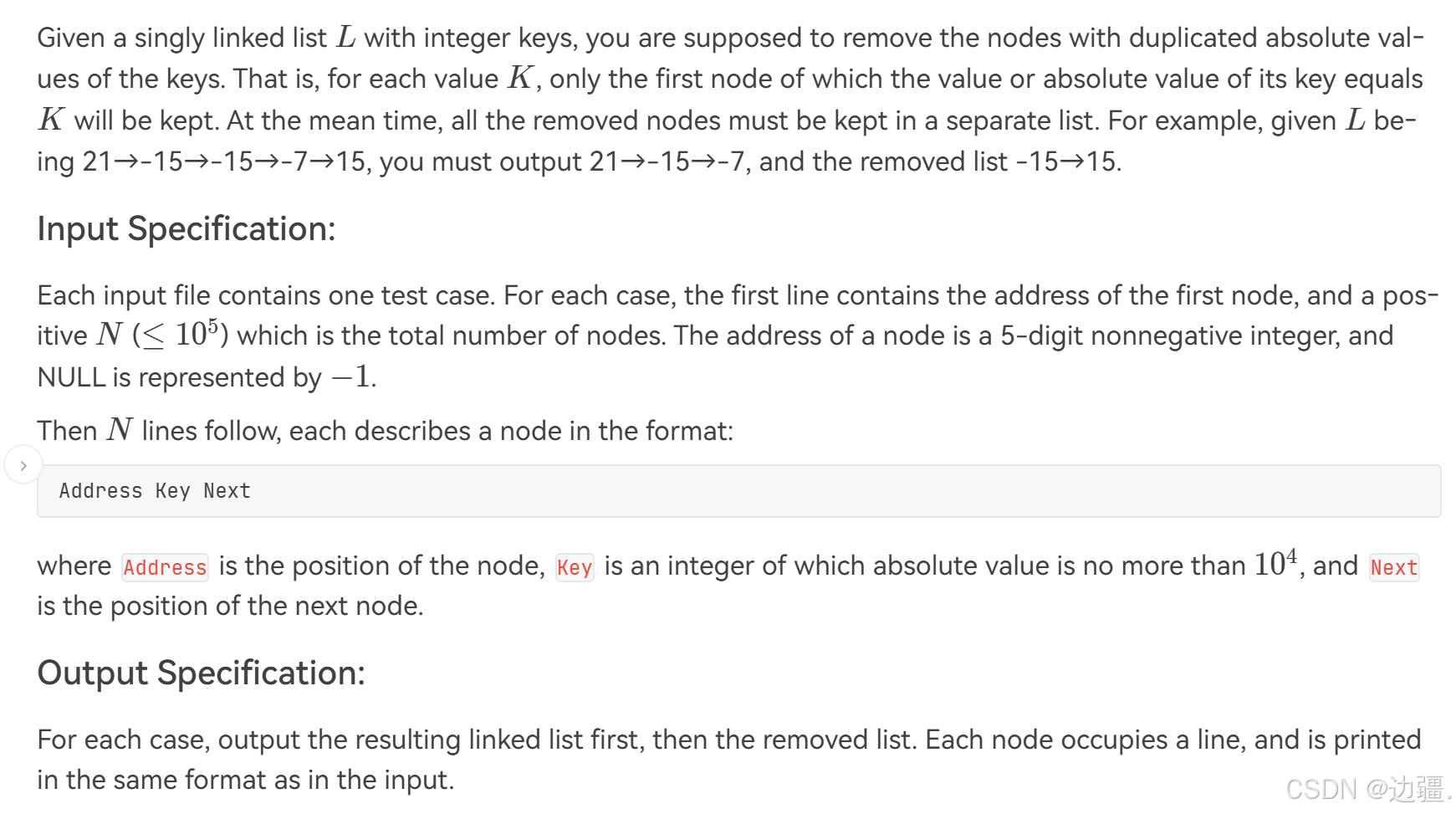
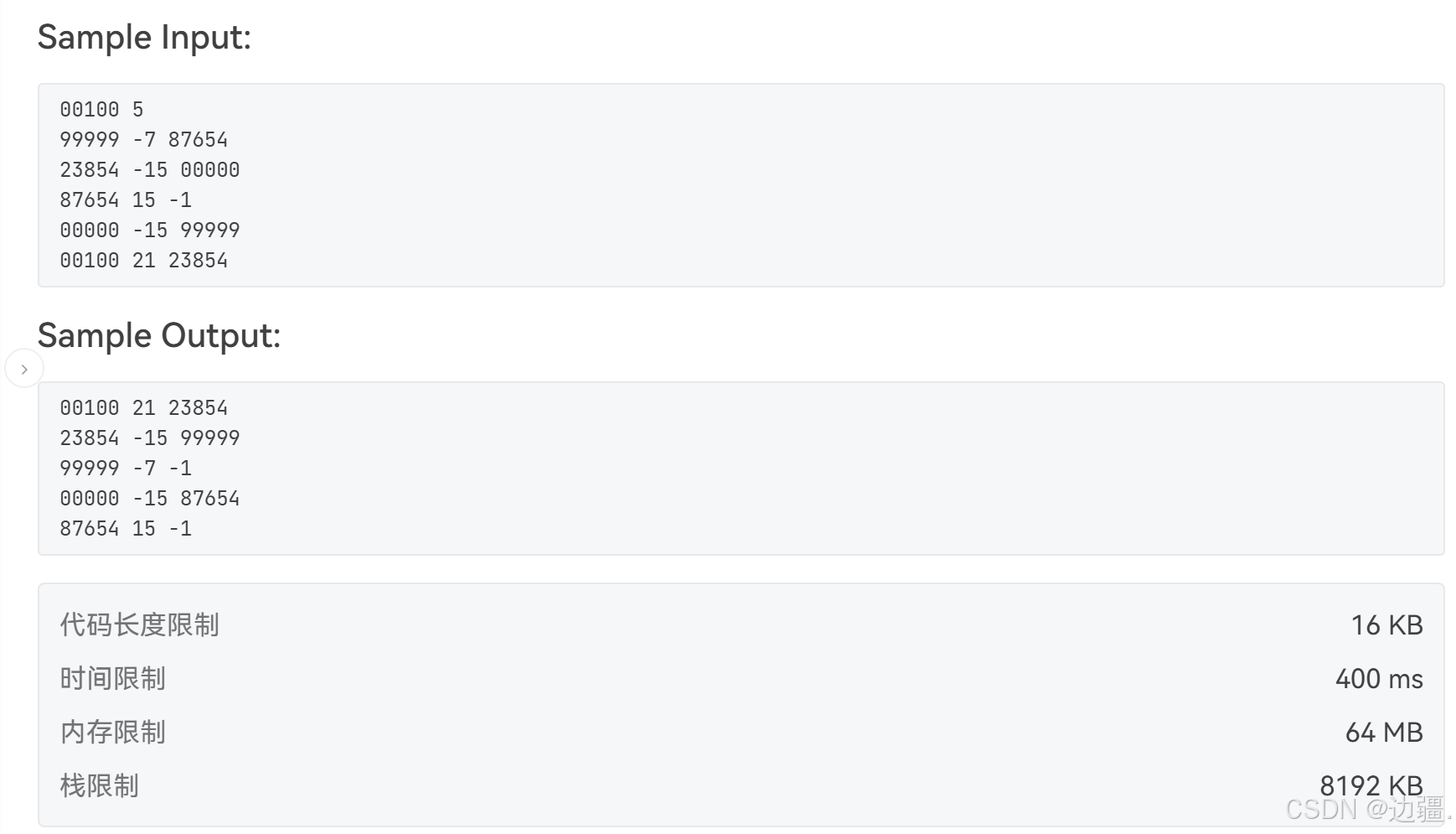
题目大意
给定一个单链表 L,链表上的每个节点都存有一个键值,要删掉其中拥有重复键值绝对值的节点。也就是说,对于每个值 K,只保留键值或键值绝对值为 K 的第一个节点。同时,被删掉的节点被保存在另一个单独的链表中。
输入格式
第一行首先包含头节点地址,然后包含节点总数 N 。节点地址用一个 5 位非负整数表示(可能有前导 0),NULL 用 −1 表示。
接下来 N 行,每行描述一个节点的信息,格式如下:
Address Key Next
其中 Address 是节点地址,Key 是一个整数表示键值,Next 是下一个节点的地址。
输出格式
首先按顺序输出结果链表,然后按顺序输出删除链表。
每个节点占一行,格式与输入相同。
数据范围
1≤N≤10^5
节点键值的绝对值不会超过10^4
解题思路
这道题的数据范围不大,我们可以先定义一个节点结构体,里面存放键值key和下一个节点的地址ne,再定义结构体数组slist表示一个单链表。定义一个unordered_map<int, bool> mp 来判断节点的键值以及键值绝对值是否存在,再定义一个vector< int > ans[2] 容器,ans[0]用来存储原链表节点的地址,ans[1]用来存储删除链表节点的地址。
从头节点开始遍历整个链表,如果该节点的键值绝对值没有存在过就将该节点地址存储在容器ans[0]里,再将该节点的键值绝对值标志为存在,否则,就将该节点地址存储在容器ans[1]里。一直遍历到节点地址为空为止。
先输出结果链表,再输出删除链表。因为节点地址输出的格式是五位非负整数,可能还有前导0,我们可以用C语言的printf函数实现:
c
printf("%05d", node);该代码的意思就是输出一个整数,占5位,如果不足5位就用0来补齐,默认为向右对齐。
还可以用C++的iomanip头文件中的一些函数来格式化输出,比如:setw(n),setfill(n)
setw(n):设置输出字段的宽度,如果输出内容小于字段宽度,就会默认填充空格并且默认为向右对齐。
setfill(n):设置用于填充输出字段的字符,通常和setw一起使用。
AC代码
使用C语言的printf函数输出
cpp
#include<iostream>
#include<vector>
#include<unordered_map>
using namespace std;
const int N = 1e5 + 10;
struct node {
int key;
int ne;
}slist[N];
int main()
{
int head, n;
unordered_map<int, bool> mp;
cin >> head >> n;
while (n--)
{
int adress, key, next;
cin >> adress >> key >> next;
slist[adress].ne = next;
slist[adress].key = key;
}
vector<int> ans[2];
while (head != -1)
{
if (mp[abs(slist[head].key)] == false)
{
ans[0].push_back(head);
mp[abs(slist[head].key)] = true;
}
else {
ans[1].push_back(head);
}
head = slist[head].ne;
}
int o = 0;
for (auto it : ans[0])
{
if (!o)
{
printf("%05d %d ", it, slist[it].key);
o = 1;
}
else {
printf("%05d\n%05d %d ", it, it, slist[it].key);
}
}
printf("-1\n");
int p = 0;
for (auto it : ans[1])
{
if (!p)
{
printf("%05d %d ", it, slist[it].key);
p = 1;
}
else {
printf("%05d\n%05d %d ", it, it, slist[it].key);
}
}
//最后这里还需要特判一下,因为当单链表的节点没有重复键值时,删除链表就为空,就不需要打印-1了
if (p)
{
printf("-1\n");
}
return 0;
}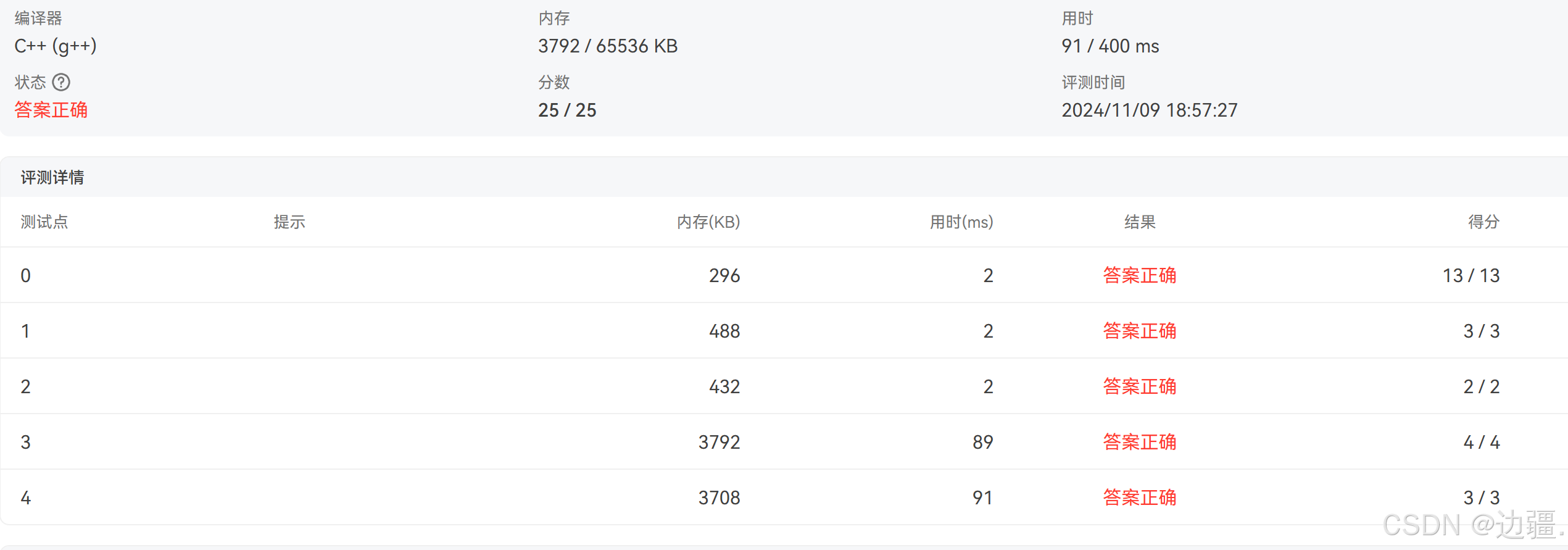
这里还有一个小坑需要注意一下 ,就是当单链表的节点没有重复的键值时则删除链表就为空了,最后的 -1也不需要打印了。不然还有两分是通过不了的。
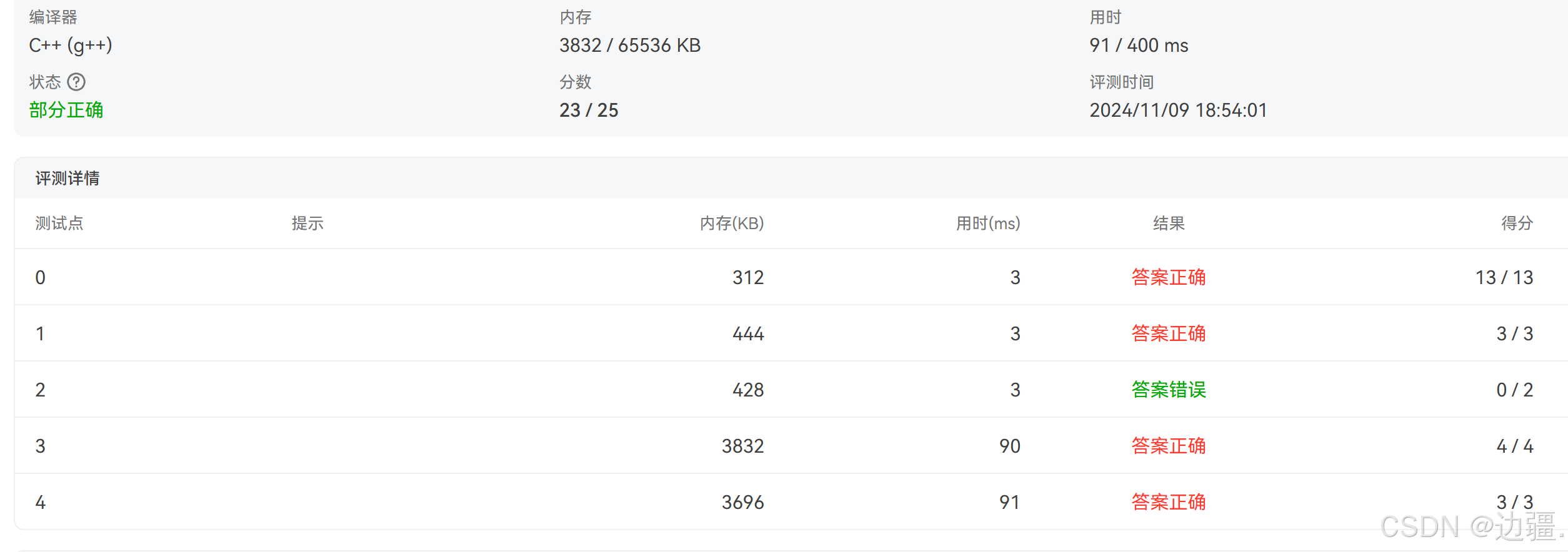
使用C++的格式化输出
cpp
#include<iostream>
#include<iomanip>
#include<vector>
#include<unordered_map>
using namespace std;
const int N = 1e5 + 10;
struct node {
int key;
int ne;
}slist[N];
void Printf(vector<int>& a)
{
for (int i = 0; i < a.size(); i++)
{
if (i != (a.size() - 1))
{
cout << setw(5) << setfill('0') << a[i] << " " << slist[a[i]].key << " " << setw(5) << setfill('0') << a[i + 1] << endl;
}
else {
cout << setw(5) << setfill('0') << a[i] << " " << slist[a[i]].key << " " << "-1" << endl;
}
}
}
int main()
{
int head, n;
unordered_map<int, bool> mp;
cin >> head >> n;
while (n--)
{
int adress, key, next;
cin >> adress >> key >> next;
slist[adress].ne = next;
slist[adress].key = key;
}
vector<int> ans[2];
while (head != -1)
{
if (mp[abs(slist[head].key)] == false)
{
ans[0].push_back(head);
mp[abs(slist[head].key)] = true;
}
else {
ans[1].push_back(head);
}
head = slist[head].ne;
}
Printf(ans[0]);
Printf(ans[1]);
return 0;
}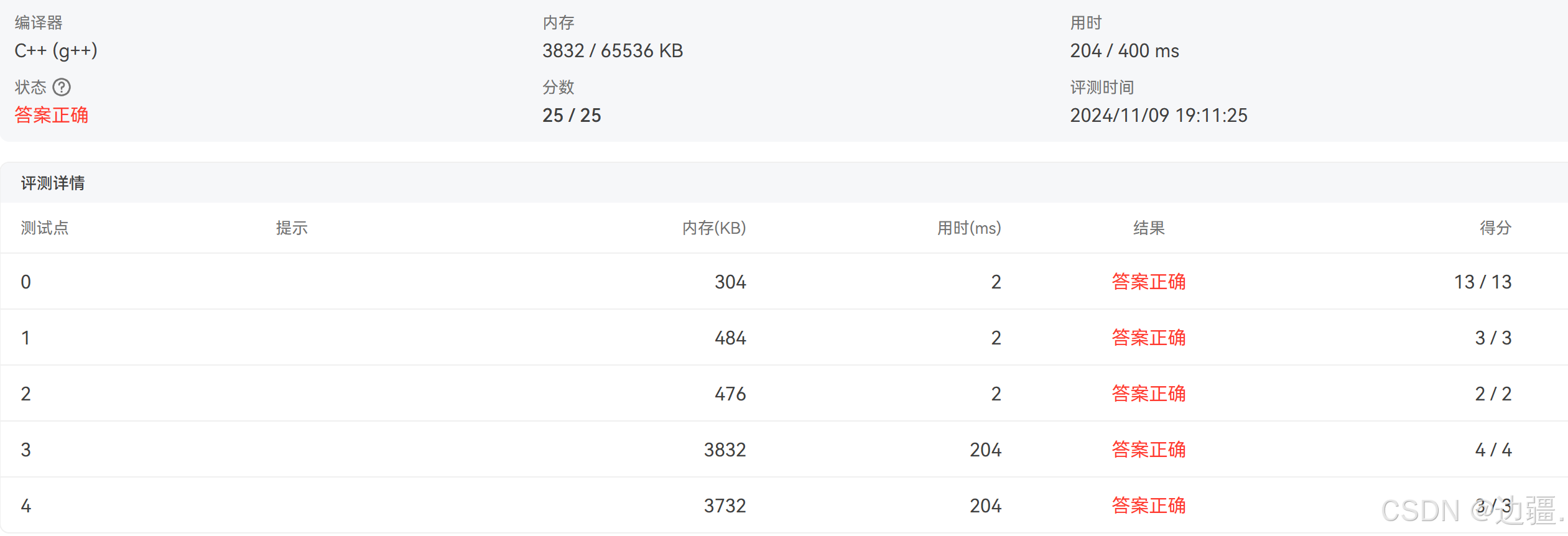
总结
这道题还是稍微好理解的,把原来链表的节点和删除链表的节点分别用容器存储起来,最后再注意一下输出格式就可以了。